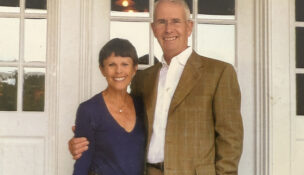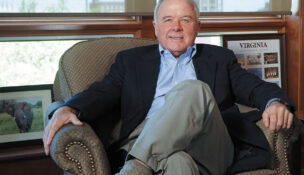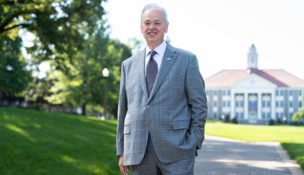Small yet mighty
VTCSOM is state’s most competitive medical school
Sydney Lake //May 30, 2023//
Way back when, Roanoke was a train city — the headquarters for Norfolk and Western Railway and a late-1800s hub for the Shenandoah Valley Railroad.
The scenic mountain community, however, has grown into a bustling region with a variety of successful industries, including one standout: health care. With the formation of Virginia Tech Carilion School of Medicine (VTCSOM), the product of a public-private partnership between the university and the nonprofit Carilion Clinic health system, Roanoke has become a hotspot for medical talent, research and development.
What was once just a brownfield a little south of the city center is now home to VTCSOM, a medical research institute and clinical facilities. In fact, VTCSOM is considered one of the major “success stories” from a brownfield grants program run by the Environmental Protection Agency. In 2008, the city of Roanoke received a $200,000 grant to clean up the scrapyards around South Jefferson where the medical school and Carilion Clinic hub stands today.
“When the people who formed the [Virginia Tech Carilion] partnership envisioned building assets that would be shared between Virginia Tech and Carilion here in Roanoke, including a research institute at a medical school, they really were thinking about transforming Roanoke from a … ‘train city’ to a ‘brain city,’” explains Dr. Lee A. Learman, the medical school’s dean since 2019.
The small medical school, which graduated its 10th class of doctors in May, has become one of the country’s most competitive medical schools. It has the third lowest acceptance rate in the nation, according to College Evaluator. For the class of 2025, 6,405 prospective students applied to VTCSOM, and just 49 students were accepted — a 0.77% acceptance rate. By comparison, 6,914 people applied to Harvard Medical School for entrance in 2022, and 226 were admitted — a 3.3% acceptance rate.
VTC is also the most selective medical school in Virginia, compared with acceptance rates ranging from 0.85% at Eastern Virginia Medical School to 4.5% at the Virginia Commonwealth University School of Medicine. VTC is also the state’s smallest medical school; it began enrolling 49 students per year in 2020, after starting with classes of only 42 students.
Dr. Aubrey Knight, senior dean of student affairs at VTC, says that this small expansion doesn’t mean the school is any less competitive.
The growth in class size is “incremental, it’s relatively small,” he says. “We’re still a very small school. Going from 42 to 49 [students], I don’t think makes that much difference in the culture of the school or in the process for admitting students. The process for admissions is more about our reputation and the growing number of people that are applying and interested in the medical school.”
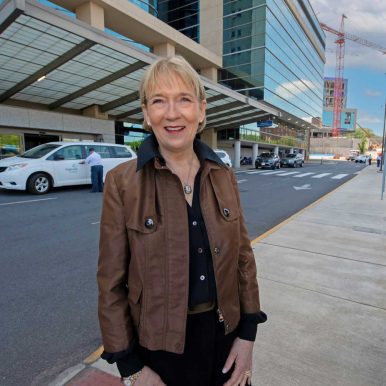
Symbiotic partnership
As its name makes clear, the Virginia Tech Carilion School of Medicine is a true partnership between the university and the regional health care system. In summer 2014, the medical school received full accreditation from the Liaison Committee on Medical Education and the Southern Association of Colleges and Schools Commission on Colleges, and on July 1, 2018, it officially became the ninth school
at Virginia Tech.
Roanoke-based Carilion Clinic operates a network of seven hospitals, as well as primary and specialty care practices serving nearly 1 million Virginians across the Roanoke and New River valleys as well as the Shenandoah Valley and Southwest Virginia. This robust network of physicians is what allowed Virginia Tech to establish its own medical school, says Nancy Agee, president and CEO of Carilion Clinic, which has grown into an almost $2 billion medical system over its nearly 125-year history.
“The school doesn’t exist without us. It’s very much a clear and compelling partnership,” she says. “Medical students, residents, fellows and faculty, all those are intricately linked.” Carilion Clinic physicians train medical school students; Virginia Tech does not employ the professors, she explains. This has been a symbiotic relationship — in that Carilion Clinic employs more than 1,000 physicians, up from the 600 the organization had when Agee became CEO in 2011.
Currently, there are 600 Carilion Clinic physicians who are also VTCSOM teaching faculty. These 600 physicians are paid exclusively by Carilion; however, the medical school has a total of 871 faculty, with the others having different employers and affiliations. Virginia Tech employs 78 faculty members.
“It’s been a sea change, frankly, and the School of Medicine has been a catalyst for it,” she says. “It was part of our plan at the beginning, so we’re achieving that vision.”
While Virginia Tech Carilion medical students don’t have guaranteed residency programs with Carilion Clinic, some end up “matching” with one of Carilion’s programs. Upon graduation from medical school, students across the country participate in a matching process in which prospects rank their top residency programs, and the medical programs do the same with the students. Medical grads typically match with a residency program, which can vary in specialty, length and location. For the VTC class of 2023, seven students matched with Carilion, and since 2014, 57 students have matched with the regional medical network.
Others, though, have matched with increasingly competitive programs, including Massachusetts General Hospital, Mayo Clinic School of Graduate Medical Education, and Ronald Reagan UCLA Medical Center. So far, VTC has had a 100% match rate for students pursuing residencies, which is somewhat rare, even at other highly regarded medical schools.
“The factor is more about our graduates performing well and opening the door for subsequent students,” Knight says. “We’ve always had very strong students. Other people are recognizing that to a greater degree.”
Sahana Nazeer, who graduated from VTC in June, will return to her hometown, Boston, for a child psychiatry residency program at Brigham and Women’s Hospital, consistently ranked as one of the nation’s best hospitals. Coming from Brown University, Nazeer wasn’t necessarily eager to move to Roanoke — a city mostly unknown to her — but it quickly felt like a place where she could build a community. With small class sizes, Nazeer says she felt comfortable approaching and working with her classmates.
“I feel like I walk away from medical school feeling like I’ve had an individual relationship with each person in my class,” she says. “I don’t know many med students that could really say that, too. I can 100% say, now, four years later, I’m going to miss Roanoke.”
That sense of community largely hinges on the school’s problem-based learning, in which small groups of students work through medical scenarios together, teaching each other how to be successful in practice.
Dr. Adam Tate, a 2018 VTC graduate, also found that having significant direct contact with faculty, medical residents and attending physicians made his medical school experience an “involved and immersive classroom and clinical learning environment,” he says. “I developed both amazing friendships and professional relationships from my time in the program.”
Research chops
Because VTC is so competitive, incoming students often have serious research chops.
“We really do want a student who has some experience in and can hit the ground running with research,” Knight says. “While we have a curriculum and we do teach them the basics of clinical research and biomedical research, we expect that they’ve had some experiences prior to coming, so that it’s not a shock.”
Virginia Tech Carilion students, staff and faculty note that the school’s focus on research is another factor that makes it unique when compared with other medical schools. That’s largely due to the Fralin Biomedical Research Institute at VTC, which was founded in 2010 and focuses on the study of diseases such as brain disorders, heart disease and cancer.
“Fralin does some very significant biomedical research, and students are very involved with Fralin and our faculty,” Agee says. “Something that we’ll continue to focus on is commercialization of research,” including redesigning medical products by using artificial intelligence and machine learning.
All medical students are expected to conduct weekslong “original, hypothesis-driven research” during their three-and-a-half-year medical school journeys. Plus, each student receives $1,000 per year for research supplies during years two through four.
The outcomes have been impressive over the past decade: More than 100 students have published their research, and nearly 400 have presented their findings at regional, national or international conferences. In March, VTCSOM hosted its Medical Student Research Symposium, highlighting student research.
VTCSOM’s focus on research is very different from old-school medical training, Learman explains. Many medical schools have academic departments focused on different disciplines, including physiology, biochemistry and anatomy, and were built out with large faculties lecturing students.
“It’s hard when you’re a student learning abstract knowledge and principles to not understand how those get applied in actual patient care,” Learman says. “Our students finish with a research certificate. When they get to residency, they’re far more facile with how to implement knowledge to impact clinical decision-making as a result of these research requirements they’ve been able to fulfill over the four-year curriculum.”
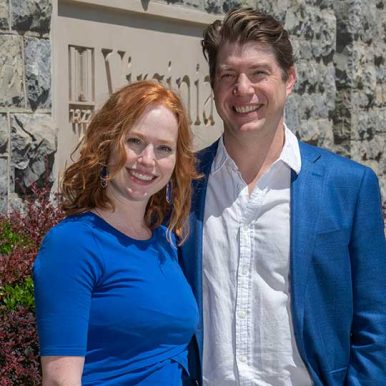
Return to Roanoke
Roanoke may not always be the first place VTC graduates practice medicine, but it’s often a final destination. Both Tate and his wife, VTC alum Dr. Megan Whitham, pursued residencies elsewhere before returning to Roanoke to work at Carilion Clinic.
Whitham works in maternal fetal medicine, while Tate practices family medicine. Originally from Carroll County, Tate was “psyched” to get to study medicine near home and Southwest Virginia’s Appalachian Mountains, a region negatively affected by a shortage of doctors.
“We both loved being here during school and made many important connections, which contributed to our desire to move back once we were finished with residency and fellowship training,” Tate says. Plus, Whitham notes, Roanoke was “an exciting place for us to come back to because it has been developing quickly, and there is a growing young professional community that is so welcoming in this area.”
About 25% of VTC students stay in Virginia for their residencies, Learman says, and of the 408 students who have graduated from the medical school so far, he anticipates about 100 of them will come back to the state to practice.
“We’re also happy that we can create a net increase in the Virginia workforce by attracting people from outside of Virginia who fall in love with this region and may go away temporarily to do residency but come back ultimately to live and to work,” Learman says.
Incremental growth is what’s next for the school, officials say. This will include the construction of more medical training space and the small increase in the number of new students at VTC to 49 in 2024.
Architectural planning for the future building hasn’t begun yet, and timelines aren’t mapped out, but officials envision the new construction to more than double the size of the current 51,000-square-foot facility, a VTCSOM spokesperson says. While a target class size hasn’t yet been determined, the expansion could allow the school to double in enrollment. However, the school would not enroll more than 100 students per class, “which would still be a small medical school by national standards,” the spokesperson adds. (The median medical school class size nationally is 140 students, with a range of 40 to 250, according to the Journal of the Association of American Medical Colleges.)
“The transformation of an industrial brownfield into a rapidly growing health science and technology campus over the past decade is a remarkable success story for the Roanoke-Blacksburg region and the commonwealth as a whole,” says Virginia Tech President Tim Sands. “We are excited about the next phase of growth for VTCSOM.”
Virginia Tech At a glance
Founded
Virginia’s original land-grant university, Virginia Tech was known as Virginia Agricultural and Mechanical College when it was founded in 1872. Virginia Polytechnic Institute and State University is the state’s second largest public university by enrollment.
Campus
Virginia Tech’s Blacksburg main campus stretches over 2,600 acres. Tech also has regional presences statewide and a study-abroad campus in Switzerland. The university’s Innovation Campus for computer science and computer engineering graduate students will open in Alexandria in 2024.
Enrollment (2022-23)
Undergraduate: 30,434
Graduate and professional: 7,736
In-state: 23,885
International: 3,884
Students of color: 8,741
Male: 57%
Female: 43%
Employees
Full-time employees: 8,538
Research and teaching
faculty: 2,766
Tuition and fees, housing and financial aid*
In-state: $15,476
Out-of-state: $36,393
Room and board: $11,746
Average financial aid awarded to full-time, in-state undergraduates seeking assistance in 2021-22: $8,588
*2023-24 figures, except as noted
F








